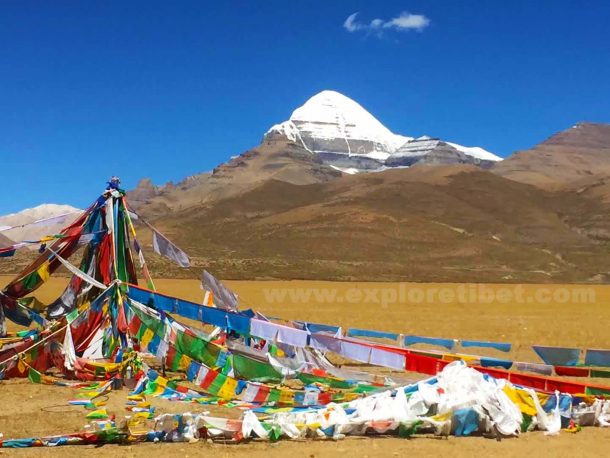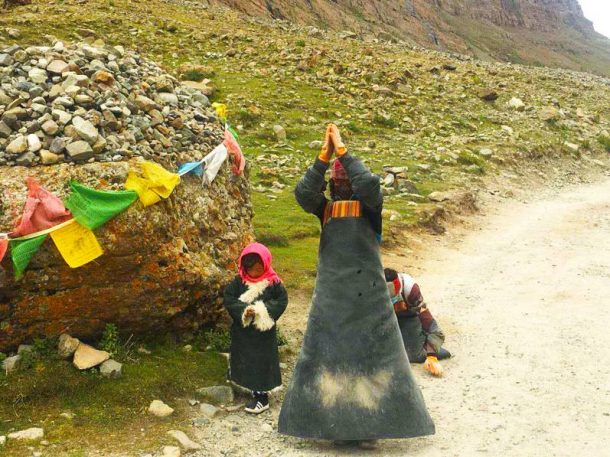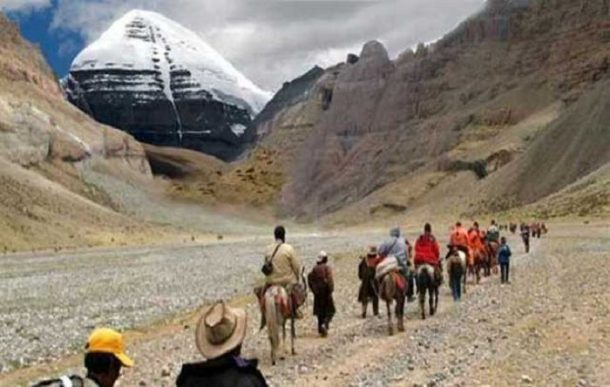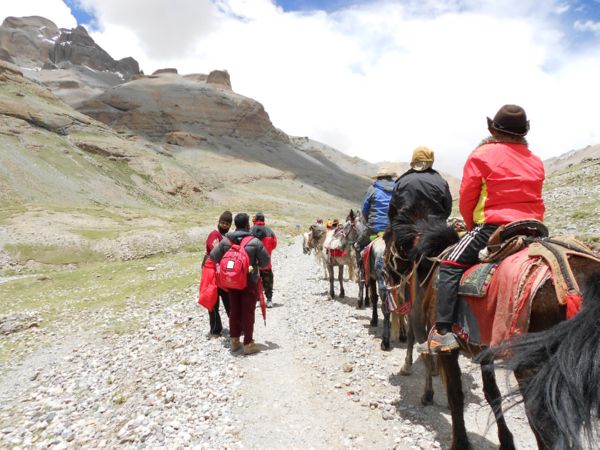
The Religious Legends of Mount Kailash
Lying far out in the west of Tibet, the highest peak of the Gangdise Mountains. Mount Kailash is considered as the most sacred mountain in the world. Sitting at an altitude of 6,638 meters above sea level. The stunning peak of this unique pyramid-shaped mountain has never been conquered by modern man. In fact, only one man has ever been known to have reached the summit of this mountain, and he never set foot on its slopes.

Mount Kailash in Tibet
Many legends surround the most sacred mountain on Tibet’s vast plateau. Held in reverence by four different religions in Southeast Asia – Hindus, Buddhists, Jains, and the Bonpo. The mountain is the focus of one of the most important pilgrimage treks in history. Mount Kailash holds a great significance in the four religions, being the center of the universe in three and the home of the most powerful god in the fourth. Mount Kailash has long been the center of many mysteries, myths, and legends. And maybe there could be some small amount of truth to some of them.
Table of Contents
Buddhism
For Buddhists, the sacred mountain is central to Buddhist cosmology, and for Vajrayana Buddhists. It is believed to be the home of the Buddha Cakrasaṃvara, known locally as Demchok, the god of supreme bliss. The most well-known legend of the mountain is that of the Vajrayana champion, Milarepa, the only man to have set foot on the summit.

Buddhist followers prostrating around the Mount Kailash
When he first came to Tibet. He challenged the Bon mage, Naro Bon-Chung, to a battle over supremacy of the sacred mountain. The two sorcerers became embroiled in a huge battle of magic lasting for days. But neither could gain the upper hand, so well matched were their skills.
Finally, the two mages agreed that the decisive contest would be a race to the summit of the mountain. As soon as the race began, Naro Bon-Chung sat on his magic drum and began to soar up the slopes of the mountain, while Milarepa simply sat meditating. As Naro Bon-Chung neared the top of the mountain. Milarepa jumped up and stepped onto a ray of sunlight, quickly overtaking Naro Bon-Chung and riding it to the very peak of the sacred mountain. While he stood on the summit, he took a handful of snow and cast it across the valley to the nearby mountain now known as Bönri. He bequeathed this new mountain to the Bon people, known as Bonpo. And ensure their connection to the area of the sacred Mount Kailash forever.
Hinduism
For the Hindu followers, the mountain is known as Kailāsa. It is believed that the god, Lord Shiva, resides at the top of the mountain, with his wife, Pārvatī. Believed in Hindu religion to be the founder of Yoga, Lord Shiva is also known as the “Adi-Yogi”.
For Hindus, the legendary Mount Kailāsa is believed to be one of the pillars of the world. Located in the midst of six mountain ranges that form the shape of a giant lotus. One description of the legendary mountain describes its four faces as being made of gold, crystal, ruby, and lapis lazuli, making it a mountain in the shape of a pyramid.

On the pilgrim’s kora trail around Mount Kailash
For the Hindus, the sacred Mount Kailash is the earthly representation of the legendary Kailāsa. Therefore it is the gateway to the home of their most important god, Lord Shiva. As one of the most sacred earthly representations in Hindu mythology, Mount Kailash has become a major place of pilgrimage for Hindus from India. It is an important part of their lives, with hundreds of thousands of Indian pilgrims applying to make the Kailash Yatra every year.
Jainism
In the Jain faith, which is one of the most ancient Indian religions, the mountain if the earthly representation of the legendary Mount Meru, the center of the universe. The sacred five-peaked mountain that is present in Jain, Buddhist, and Hindu cosmology, Mount Meru is considered to be the center of all universes, including the physical, the metaphysical, and the spiritual.
The mountain closest to Mount Kailash in Tibet, known as Mount Ashtapada. It is believed to be the site where the first Tirthankara (the savior and spiritual teacher) of the Jain religion, Rishabhadeva, reached his liberation or enlightenment. Ashtapada is also believed to be one of the five peaks of Mount Meru on Earth.
Bonism
The Bonism is the native religion in Tibet. It considers the mountain to be the legendary nine-story Swastika Mountain of Bon religious texts. This ancient Tibetan religion, which at the time it was prevalent on the plateau had no actual name, nor was it actually recognized as a formal religion as they are known today. The followers believe that Mount Kailash is the earthly representation of the Yungdrung Gutsek. And the pyramid-shaped mountain that serves as the axis mundi in their spiritual realm of Tagzig Olmo Lung Ring.
According to the tertons that resurfaced in the 10th and 11th centuries. And reinforcing the Bon faith in parts of Tibet. The originator of the religion, Tonpa Shenrab Miwoche was born in the spiritual realm. And it was during a sojourn to the area of Mount Kailash that his horse was stolen by a demon, leaving him stranded. Due to the sacredness of the axis mundi, which is believed to be Mount Kailash, the left-facing swastika is held to be auspicious.
By looking at the side of Mount Kailash at the right time of the year (when it is not coated with too much snow). It shows the vertical cleft that appears to be gouged into the south face of the mountain, along with the natural horizontal layers of rock strata. It seems to make the form of a left-facing swastika. As one of the most auspicious signs in Bonism. This denotes that the mountain must be sacred and the axis mundi of Yungdrung Gutsek.
Conclusion
For all four of the religions, Mount Kailash has held a major significance in their religious beliefs. From the home of Lord Shiva to the swastika gouged into its southern flanks. It has to be said that there may well be something to the legends. And the myths that surround this unique pyramid of unusual black rock, standing far out in the desolate wastes of western Tibet. Even those who are not of one of the four religions have felt at peace. Unusual tranquility when trekking around the kora route at the base of the sacred mountain.

Riding ponies around the Kailash Kora
So there are many other myths and mysteries also surround the mountain. The only mountain in the world that nobody seems to want to climb, even if they could. Is this Mount Meru, the center of the universe? Does Lord Shiva live at the summit? Only Milarepa could answer that one. Though would we really want an answer. Whatever the reason this innately spiritual mountain has for making people feel at peace, it is enough that it does.
Recent Posts
The Perfect Tibet Tour Package
Journey to Tibet
Exploring Tibet
All Categories
- About Tibet
- book a Tibet tour
- Buddhism Practice
- Budget Tour
- China-Tibet Train
- Customized Tibet tour
- Historical Sites
- Hot Springs in Tibet
- News
- Photography in Tibet
- Tibet attraction
- Tibet Group Visa
- Tibet Motorcycle Tour
- Tibet Small Group Tours
- Tibet Tours and Tibetan Tour Guide
- Tibet Train
- Tibet Travel FAQs
- Tibet Travel Information
- Tibet Travel News
- Tibet Travel Permit Update
- Tibet Travel Prices Rises
- Tibet Trek
- Tibet Trekking Tour
- Tibet weather and climate
- Tibet Wildlife animals
- Tibet Winter Tour
- Tibetan Buddhism
- Tibetan Cultural Features
- Tibetan Culture and Poeple
- Tibetan Festivals
- What to see in Tibet



